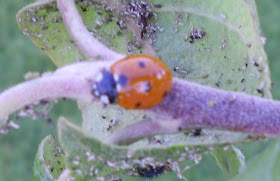
Ladybugs...

...and their larvae.


I slipped inside the farmhouse, and asked whether they had been purposely released around the "farm", or if they had just showed up. Apparently, they came on their own, and local to the area.
The children noticed right away, that both the ladybugs, and the larvae were different than what we've been seeing around our yard.
So, for a fall challenge, I've asked the older children to look online, and in printed field guides, to see if they can identify the various ladybugs we've photographed this summer, and match them with the correct larvae. Of the almost 5000 species of ladybugs, nearly 400 can be found in North America. It ought to prove quite challenging to identify the 5 or 6 varieties we've bumped into, this summer.
I've already identified a couple, like the Seven Spotted Ladybug (looked for by the folks at Cornell University's Lost Ladybug Project)...

 ...and the Asian Ladybug, pictured to the right, and distinguished by its oval shape, orangy color, multiple spots, and "M" on its head, but I've really been stumped by some of the others. I'm curious to see how the children do.
...and the Asian Ladybug, pictured to the right, and distinguished by its oval shape, orangy color, multiple spots, and "M" on its head, but I've really been stumped by some of the others. I'm curious to see how the children do.
It ought to keep our entomology up, well into the fall.
For more science themed fun and ideas for children, check out the Science Sunday link-up, hosted by Adventure's in Mommydom.
It's great to be a homeschooler.
Fascinating-I hadn't realised that there are so many varieties.
ReplyDeleteWe call ladybugs "ladybirds" here in the UK. Haven't tried to identify them though-we have some yellow ones as well as the more common red types.
Well, you taught your children well to pay the closest attention to the tiniest things. I hope they had fun on your overnight trip!
ReplyDeleteI had no clue there were so many different varieties of lady bugs! Now you've got me wondering about what kinds we have around here... :) Funny that the ladybugs were what they wanted to look at...with all that other "stuff" around them. :)
ReplyDeleteI hope you enjoyed your trip! Your children are wonderful students!! You must be proud!!!
ReplyDeleteSarahElisabeth - I wonder how many types live in the UK?
ReplyDeleteChristy - Yes, it almost made up for walking up on one of the kids, at a kid's festival, last weekend, and hearing an adult at a water cycle table asking if she knew which ocean the Columbia river flowed into - and hearing my child say, "...uh...I don't know...we might be studying that this year...we homeschool." :)
On no on the river thing..... Those pictures would be an excellent example of why I'm not good for identifying insects and such. I didn't see those OBVIOUS differences.
ReplyDeleteIt always amuses me what kids will latch onto.
You have done a fantastic job teaching your children to stop and look at all of God's creation and not just the earthly things! As my mom would say..."They truly know the meaning of stopping and smelling the roses."
ReplyDeleteJust came upon your sight. I homeschool my 8 children. After 17 years of doing so, I feel slightly out of ideas & burned out. I had lost sight of the fun of homeschooling. I am renewed after reading & printing out some of your projects & ideas for our family to do this week....thanks!
ReplyDeleteIt isn't easy spotting the differences, is it?
ReplyDeleteWe have lady bugs in our house all the time but I have to say I never knew there were so many different kinds. Interesting!
ReplyDelete